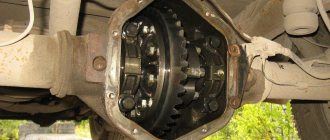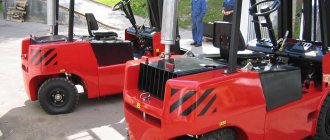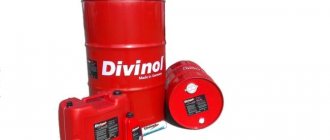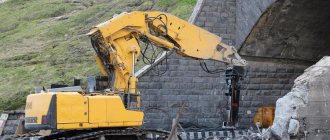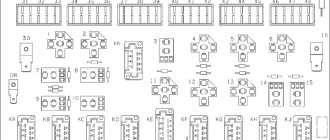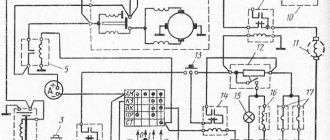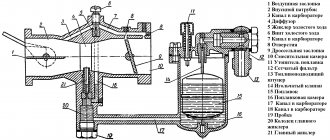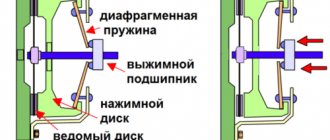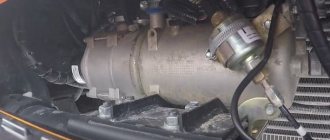Thermostat MTZ-80: Design and diagnostics
Long-term and productive operation of the tractor propulsion system largely depends on the high-quality and efficient functioning of the cooling system. It is a rather complex unit with many parts and components, among which the MTZ-80 thermostat, despite its miniature size, plays a fairly important role. It is the features of this unit that will be discussed in this material.
Thermostat - MTZ-80 (2009):
245-1306030-A 245-1306040 1 2 3 4 5 6 7 8 9 9 9 10 11 12 13 14 14 15 15
List of components from Thermostat for MTZ-80 (2009)
Parts diagrams are for reference purposes only! We do not sell all spare parts from Thermostat for MTZ-80 (2009) presented in this list. If there is a “Show prices” link in the right column, these spare parts from “Thermostat” are on sale. Availability in warehouses for details and prices, see the product card. If there is no “Show cost” link in the right column, we do not sell such parts and do not accept orders for them.
| № | Part code | Name | Quantity per model, pcs. | Show all prices |
| 7 | 245-1306025 | Lid | 1 | Show prices |
| 9 | TS107-1306100-04 | Thermostat | 1 | Show prices |
| 11 | 245-1306021 | Frame | 1 | Show prices |
| 12 | 245-1306027 | Union | 1 | Show prices |
What does a modern MTZ thermostat consist of?
The part with filler has the following design:
- Rod;
- Durable housing;
- Valves (there are two models - bypass and main);
- Insert;
- Springs;
- Cylinder;
- Brace and several fillers;
- Compression spring and rod.
There are two types of valves mounted on the cylinder: bypass and main.
Inside the thermostat on MTZ 80 or 82 there is an insert, the end of which is placed in the cylinder. Gradually pressing on the surface of the washer, the spring holds the thermal power element only in the lower position.
The passage of liquid to the tractor radiator is closed by the neck of the MTZ thermostat housing.
Operating principle
The operating principle of this device is based on a small cylinder mounted on the side facing the engine. Inside it is completely filled with artificial wax, which begins to melt when it reaches 82 degrees Celsius. Wax was chosen as a working material due to its unique property of expanding with increasing temperature and transitioning to a liquid state from a solid.
The control pin is pressed into the wax on one side and connected to the valve on the other. As the wax melts, it expands, forcing the pin out of the cylinder and opening the valve, allowing coolant to pass through the thermostat.
When the engine is turned off, the thermostat, and therefore the wax inside the cylinder, cools down, closing the valve.
Not available:
| № | Part code | Name | Quantity per model, pcs. | |
| 245-1306030-A | Installing the Thermostat Housing | 1 | Not available | |
| 245-1306040 | Thermostat housing | 1 | Not available | |
| 1 | M8x25 | Bolt | 1 | Not available |
| 2 | M8x95 | Bolt | 1 | Not available |
| 3 | 50-1401067 | Washer | 4 | Not available |
| 4 | 50-1306026 | Pad | 1 | Not available |
| 5 | M8x25 | Bolt | 4 | Not available |
| 6 | 50-1401067 | Washer | 4 | Not available |
| 8 | KG3/8-A12-016 | Cork | 1 | Not available |
| 9 | TA107-04 | Solid thermostat | 1 | Not available |
| 9 | TR4-02 | Solid thermostat | 1 | Not available |
| 10 | 245-1306023 | Pad | 1 | Not available |
| 13 | 80-3801092-B | bracket | 1 | Not available |
| 14 | 50-1306028-B3 | Hose | 1 | Not available |
| 14 | 50-1306028-B4 | Thermostat hose | 1 | Not available |
| 15 | 20-32NORMA-TORRO | Clamp | 2 | Not available |
| 15 | XC-26-019 | Clamp | 2 | Not available |
Can't find the required part from the Thermostat group for MTZ-80 (2009) ? Consult our specialists by phone 8-800-700-19-88 or by email. We will definitely help you!
Leave a request in any form
Engine cooling system D 240
tractor MTZ 82 - closed, with forced circulation of liquid. The cooling system consists of the following main components: water pump (pump), thermostat, water radiator, fan, curtain, thermometer, and also includes drainage and water supply pipes, connecting fittings, hoses, drain taps, etc.
Cooling system diagram
1
— radiator cap;
2
- radiator;
3
- water supply pipe;
4
— thermostat;
5
- thermometer;
6
- water pump;
7
— drainage pipe;
8
- fan;
9
— curtain;
10
— faucet for draining water from the radiator.
Radiator of the MTZ-82 tractor
A water radiator is used to cool water, which is heated in the water jacket during diesel operation. After passing through the radiator, the water is cooled under the influence of the blowing air flow from the fan. The radiator consists of a core, which consists of four rows of flat vertical tubes passed through a row of horizontal plates soldered to them. The core plates and tubes are usually made of brass. The ends of the tubes are soldered to the main outer and much thicker plates and protrude slightly above their surface. For better heat transfer, a stepped placement of tubes along the depth of the radiator was used.
The lower and upper brass tanks are attached to the main plates using bolts. There are rubber gaskets between the tanks and the plates. To connect the tanks, racks running on both sides of the core are used. There is a water supply pipe on the back wall of the upper tank. At the top of the tank there is a neck for filling water, closed with a plug with a steam-air valve. On the back wall of the lower tank there is a drain valve and a drainage pipe.
The radiator is installed on an elastic mount: it is attached to the front beam on supports with rubber shock absorbers, and at the top it is attached to the cylinder head with braces.
To create an active air flow, a fan is used to blow through the cores of the water and oil radiator, as well as to cool the outer surface of the engine. The fan is located in a single unit with the water pump and is located on its shaft. Using six bolts, the fan is attached to the pump pulley, and the entire complex (water pump-fan) is bolted to the top of the front side of the cylinder block. The fan shroud is attached to the rear of the water radiator struts and serves to protect the fan from foreign objects, as well as to direct the air flow to the engine.
Radiator and fan
1
- fan;
2
- hub;
3
- key;
4
- pump shaft;
5
- pulley;
6
— retaining ring;
7
- oiler;
8
- spring;
9
— impeller;
10
- cuff;
11
— clip;
12
- sealing washer;
13 and 16
— oil seals;
14
— body;
15
— fan belt.
Engine water pump D 240
The water pump of the MTZ 82 tractor, a centrifugal type, is designed to create intensive circulation of liquid in the cooling system and, with this, more efficiently remove heat from heated engine components. The water pump impeller is mounted on a shaft and secured against rotation using a flat. The impeller is secured to the shaft with an end bolt. Two ball bearings allow the roller to rotate together with the impeller. The volume in the housing between the bearings is filled with lubricant using a grease gun. The oil and water cavities of the pump are separated from each other by an additional mechanical seal located in the impeller. The seal is a textolite washer that contacts the well-machined end of the thrust bushing, pressed into the pump body, as well as a rubber cuff surrounding the roller and pressing the springs.
The impeller is located in the profiled cavity of the water pump housing. During rotation of the impeller, a vacuum is formed at the entrance to this cavity, which is transmitted to the receiving chamber, connected by a pipe to the lower radiator tank. Using a vacuum, the liquid is supplied to the impeller blades and, under pressure, is fed into a spiral channel, called a volute, surrounding the impeller in the pump housing. Next, the liquid is pumped into the longitudinal channel of the engine cooling system.
The diesel water pump D 240 and the fan rotate from the engine crankshaft pulley using a V-belt, which also rotates the generator rotor. At rated engine speed (2200 rpm), the fan and pump develop 2600 rpm.
MTZ 82 tractor thermostat
The thermostat is necessary to automatically maintain the temperature in a given range and speeds up the engine warming up after starting. The thermostat device includes a housing, lower auxiliary and upper main valves, and a thermostat sensor with solid filler. The thermostat housing is made of brass, with two windows on the side surface. The upper part of the housing serves as a seat for the main valve, and the lower part serves to secure the housing in the thermostat box. The auxiliary valve lever and the main valve are attached to the top of the sensor.
The thermostat is located in the housing and is installed at the outlet of the cylinder body cooling jacket. A thermostat with a solid filler is less sensitive to changes in pressure in the system and has greater adjustment forces compared to a bellows thermostat.
When the coolant temperature is less than 70º C, the main valve is closed, and the liquid is supplied through the windows through the pipe into the pump and then into the water jacket of the cylinder block. This way, the liquid does not pass through the radiator and therefore heats up faster. At a liquid temperature of more than 70º C, the volume of the mixture of cerisin with aluminum powder increases, the piston with the main valve installed on it is activated, and coolant access to the radiator opens. At the same time, the auxiliary valve blocks the windows for supplying fluid to the water pump, bypassing the radiator.
A curtain mounted in front of the water radiator regulates the volume of air passing through the radiator, thereby regulating the temperature of the liquid within a certain range. The curtain is controlled from the tractor driver's workplace using a handle connected by a cable to the movable roller of the curtain. The temperature of the coolant in the system is visually monitored using the readings of an electric thermometer, the sensor of which is mounted in the cylinder head, and the indicator itself is located in the cockpit on the instrument panel.
Thermostat
1
- frame;
2
- auxiliary valve;
3
- window for water passage;
4
— sensor rod;
5
- main valve;
6
- sensor.
Maintenance of the D-240 engine cooling system
First of all, it is necessary to inspect all connections, monitor the serviceability of components and assemblies, the quality and level of the coolant being poured.
The cooling system must be filled only with purified water. Pay attention to the hardness of the water - hard water creates scale on the walls of the jacket, which is a poor conductor of heat and, therefore, slows down the transfer of heat from the head and walls of the cylinder block. It is recommended to use rain or snow water, which is softer, as a coolant. The hardness of water can be softened by boiling it with the addition of 10-12 grams of washing soda per 10 liters of water. The drained water from the cooling system is close in properties to boiled water and can be collected for subsequent refilling. The water is drained only when the engine is sufficiently cooled after a complete stop. The coolant temperature during engine operation should not exceed 95º C.
If the temperature rises critically, check the fluid level in the radiator and its leakage from it, as well as the degree of tension of the fan belt. Water is poured into an overheated engine evenly and always while the engine is running. During sudden cooling, there is a possibility of cracks in the cylinder head and water jacket. Do not add too hot water to a cold diesel engine in winter.
The cooling system is descaled every 960 hours of engine operation. For cleaning, you must use an aqueous solution of calcined salt (50-60 grams per liter of water). To begin with, 2 liters of kerosene are filled into the system, and then the finished solution is added. Next, start the engine and let it run for 10-12 hours. After which you can drain this liquid and refill the water.
Basic device malfunctions
The main signs that the unit has failed are the following:
- Diesel takes a long time to heat up to the optimal temperature, and its overheating occurs very quickly;
- The temperature indicators of the power plant fall while driving, and rise when stopping;
- When the engine warms up, the lower pipe remains warm for several minutes;
- The engine is very hot, and the lower pipe is consistently cold, even when the diesel engine is warm.
When to change the thermostat?
It is necessary to replace the thermostat on MTZ 82 if:
- The motor takes a long time to heat up;
- Diesel overheating accelerated;
- When stopping, the temperature of the installation rises; when moving, on the contrary, it drops sharply;
- Even when the diesel engine is warm, the engine is hot, the lower pipe is cold.
The MTZ thermostat cannot be repaired. If a spare part breaks down, we recommend replacing the unit.
In our catalog you will find everything you need for your tractor engine.
If you installed the thermostat correctly on the MTZ 82, the part will last a long time. However, most experts advise periodically checking the part as follows:
- The MTZ thermostat is closed.
- Start the engine, after a couple of minutes check the pipe that is connected to the radiator.
- The pipe must be cold. When the pipe is warm, there is a loose closure in the system.
- Therefore, it takes more time to warm up the engine. Fuel consumption also increases;
- When heated to 90 degrees, the thermostat should become hot. If the temperature of the part does not increase, it means that the MTZ thermostat is jammed.
Where is the coolant temperature sensor located, how to check for malfunctions and replace it
The internal combustion engine in operating mode is capable of warming up to a temperature of 300 degrees Celsius. At the same time, the metal expands, which can cause the cylinder block to jam (the moving glass simply gets stuck in the cylinder). To prevent this from happening, every internal combustion engine has a cooling system, in 99% of cases it is liquid.
In this case, the control unit independently regulates its operation, based on the readings of the temperature sensor. That is, if the temperature is critical, then the movement of the coolant accelerates, as well as the power of the fan to blow through the radiator.
Where is the coolant temperature sensor in the car (DTOZH)? And how to check that it is working correctly and has not failed?
What is the sensor for?
The sensor reads the temperature of the fluid in the cooling system and transmits this data to the ECU (electronic control unit). And based on this data, the on-board computer maintains the optimal temperature regime for the engine (which is about 80–90 degrees Celsius). That is, the ECU “understands” when it is necessary to slow down the fan and increase the engine temperature (when warming up), and when, on the contrary, it is necessary to reduce the temperature as quickly as possible and prevent the coolant from boiling. Thanks to this, the motor will definitely not jam, and the wear of its mechanical parts will be minimal (for example, if overheated, the same rings will quickly “burn out”).
Maintaining the correct temperature is also important for maintaining the correct viscosity of the engine oil. Only in this case will the motor be able to operate at full power, but without accelerated wear.
If the temperature sensor is faulty, then the ECU receives incorrect information. Accordingly, when the engine is cold, it can force the fan to turn on “full,” which will only complicate warming up the engine. Or vice versa: if it overheats, the fan will not work at all, which may result in engine failure without the possibility of further repair (if it jams, not only the cylinder block is damaged, but also the camshaft, crankshaft, and in some cases the flywheel).
Where is the coolant temperature sensor located?
In 99% of cases, the sensor is installed on the exhaust pipe of the cylinder block. This is the place where the coolant “leaves” the engine (that is, it is at the highest possible temperature) and then enters the radiator. In some modern cars, 2 controllers are installed: on the outlet and inlet pipes (for more precise temperature control). The sensor itself is connected to a cable (of 2, less often - 3 wires).
Visually, the DTOZH looks like a plastic “plug”, with a metal thread and an additional contact pad at the end. It must be taken into account that the sensor is in direct contact with the coolant. Accordingly, if there are signs of engine overheating, then you should not pull it out (which is necessarily indicated in the technical instructions for the car).
Principle of operation
A thermistor is installed inside the sensor - this is a type of resistor whose resistance depends on the ambient temperature. It is the resistance readings that are read and transmitted to the ECU.
Signs of DTOZH malfunction
Key symptoms of malfunction:
- Invalid engine temperature readings. For example, immediately after it starts, an overheating signal appears on the dashboard. Or vice versa: after 10 - 20 minutes of engine operation, the temperature is shown below 40 - 50 degrees.
- The fan does not turn on or off. But this may also indicate a malfunction of the control unit.
- Temperature readings are not being read correctly. In this case, the data can instantly change, for example, from 50 to 90 degrees, and then drop again.
In modern cars, if the controller malfunctions, the “Check” signal lights up on the dashboard. By connecting to the ECU, you can find out the exact cause of the alarm.

